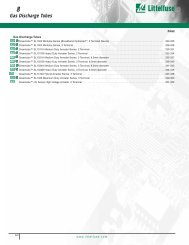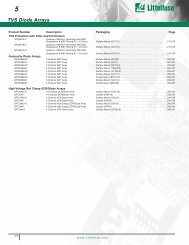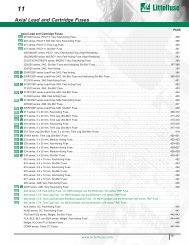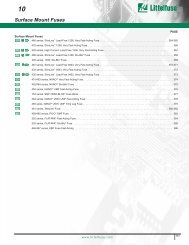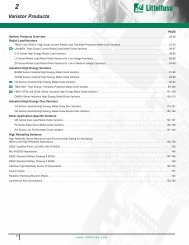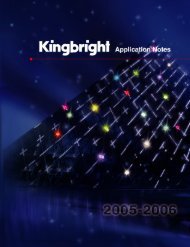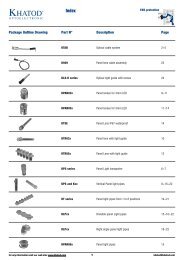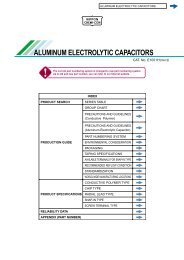Introduction to Circuit Protection
Introduction to Circuit Protection
Introduction to Circuit Protection
Create successful ePaper yourself
Turn your PDF publications into a flip-book with our unique Google optimized e-Paper software.
<strong>Introduction</strong> <strong>to</strong> <strong>Circuit</strong> <strong>Protection</strong><br />
Transien<strong>to</strong>logy<br />
Overvoltage Suppression Facts<br />
UL (Underwriters Labora<strong>to</strong>ries)<br />
UL writes “standards” <strong>to</strong> which products are investigated. Upon completion<br />
of the tests, a “Listing” or “Recognition” <strong>to</strong> the standard with conditions<br />
of acceptability is given under a unique file number. All of Littelfuse<br />
applicable Varis<strong>to</strong>rs are in the “Recognized Components” category <strong>to</strong> one<br />
or more of the following standards:<br />
• UL1449 Transient Voltage Suppressors.<br />
• UL1414 Across the Line Capaci<strong>to</strong>rs, Antenna Coupling and Line By-<br />
Pass Capaci<strong>to</strong>rs for Radio and Television Type Appliances.<br />
• UL497B Protec<strong>to</strong>rs for Data and Communication and Fire Alarm<br />
<strong>Circuit</strong>s.<br />
(Note that the terms “Approved” or “Certified” are not correct in referring<br />
<strong>to</strong> devices listed or recognized by UL.)<br />
VDE (Verband Deutscher Electrotechniker)<br />
Based in Germany, this is the Association of German Engineers who<br />
develop specific safety standards and test requirements. VDE tests and<br />
certifies devices or products, assigning a license number.<br />
Littelfuse Radial Varis<strong>to</strong>rs are currently certified under license number<br />
104846 E having successfully met CECC standard 42 201-006<br />
(issue 1/1996).<br />
ESD Standards<br />
Several industry standards and specifications exist that are used <strong>to</strong><br />
qualify and quantify ESD events. Since many circuits or systems must<br />
demonstrate immunity <strong>to</strong> ESD, these standards are often incorporated in<br />
the testing of ESD capability. Of particular concern is the immunity level<br />
for semiconduc<strong>to</strong>rs. The “standards” include Human Body Model (HBM)<br />
<strong>to</strong> MIL-STD-883, Machine Model (MM) such as EIAJ IC121, and<br />
Charged Device Model (CDM) such as US ESD DS 5.3. The Human<br />
Body Model, Machine Model and Charged Device Model<br />
primarily relate <strong>to</strong> manufacturing and testing process of an IC.<br />
One of the most severe is IEC 61000-4-2 from the International<br />
Electrotechnical Commission and referenced in the EMC directive.<br />
Level 4 of this test method is the highest level, subjecting the device<br />
under test <strong>to</strong> 8kV contact discharge method (preferred) and/or 15kV air<br />
discharge. Each Littelfuse technology is designed for this level. The<br />
recommended types are the silicon based SP05x and SP7X, the polymeric<br />
VVM based PulseGuard ® Suppressor, and the ML, MLE, MHS or<br />
MLN Multilayers.<br />
The designer should be aware of the ESD ratings of the semiconduc<strong>to</strong>rs<br />
used in the circuit. For example, semiconduc<strong>to</strong>r manufacturers that rate<br />
their devices <strong>to</strong> MIL-STD-883 <strong>to</strong> 2kV may not pass 2kV when subjected<br />
<strong>to</strong> the more difficult IEC test method (150pF / 330Ω instead of 100pF /<br />
1500Ω ). Additionally, even if semiconduc<strong>to</strong>rs do meet some level of ESD<br />
immunity <strong>to</strong> IEC standards, that does not imply that additional ESD suppression<br />
is not required. Real world ESD transients can exceed the peak<br />
currents and voltages as defined by the standards and can have much<br />
faster rise times.<br />
IEC 61000-4-2 consists of four test severity levels of ESD immunity<br />
using both a Contact Discharge and Air Discharge test method. The<br />
EUT or DUT may be subjected <strong>to</strong> increasing levels of severity until<br />
failure. Or, a particular level of immunity may be prescribed for EM compatibility<br />
of an end product.<br />
18<br />
www.littelfuse.com<br />
For more information about the IEC 61000-4-2 test method, see<br />
Application Note AN9734, “IEC Electromagnetic Compatibility<br />
Standards for Industrial Process Measurement and Control<br />
Equipment.”




